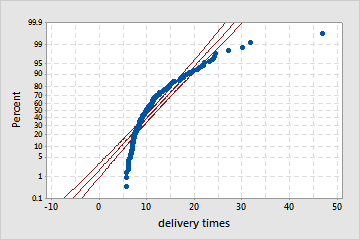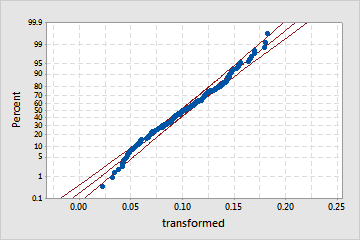What is data transformation?
If you use a capability analysis designed for normal data, such as Normal Capability Analysis, your data must follow a normal distribution. If your data are not normal, the results of the analysis will not be accurate. Sometimes you may be able to transform nonnormal data by applying a function to the data that changes its values so that they more closely follow a normal distribution.
For example, suppose you want to perform a capability analysis on the time required to deliver pizzas. Because there is a minimum time that is needed for delivery, but no set maximum amount of time for delivery, the data skews to the right. A transformation can be applied to remove this severe skewness in the data.

Before transformation
Pizza delivery times are right skewed and don't seem normally distributed.

After transformation
After the data are transformed, they more closely follow the normal distribution.
What does the Box-Cox transformation do?
The Box-Cox transformation is a power transformation, W = Y**λ, where Minitab determines the best value for λ.
Although the best estimate of lambda (λ) could be any number between −5 and 5, in any practical situation you want a λ value that corresponds to an understandable transformation, such as the square root (λ=0.5) or the natural log (λ=0).
What does the Johnson transformation do?
The Johnson transformation uses a different algorithm than the Box-Cox transformation. The Johnson transformation function is selected from three families of functions in the Johnson system. Because the functions cover a wide variety of distributions by changing the parameters, Minitab usually finds an acceptable transformation. The family Minitab selects is called the Best Transformation Type.
Perform a normal capability analysis with a data transformation
If your data are nonnormal you can try a transformation so that you can use a normal capability analysis.
- Choose . Click Transform.
- Choose a transformation:
- Box-Cox transformation
- This transformation is easy to understand and provides both within-subgroup and overall capability statistics.
- Johnson transformation
- This transformation is very powerful, and it can be used with data that include zero and negative values, but it is more complicated and it only provides overall capability statistics. Use this when the Box-Cox transformation does not find a suitable transformation.
- Specify transformation options, if you like, then click OK.
